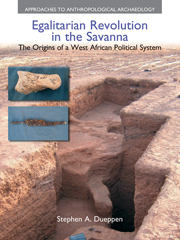Book contents
- Frontmatter
- Dedication
- Contents
- List of Figures
- List of Tables
- Acknowledgments
- 1 Decentralization and the Evolution of Egalitarian Behaviors in Sedentary Societies
- 2 Ancient Villages in the Niger Bend: Context and Methods for Exploring the Voltaic Region
- 3 Ethnographic Perspectives on Western Burkina Faso: A Survey
- 4 Kirikongo: An Introduction to the Site, the Setting, and the Research Design
- 5 The West African Environmental Setting: Kirikongo in Ecological Context
- 6 Stratigraphies and Depositional Episodes: The Excavations
- 7 Relative Chronology: Ceramics
- 8 Community Growth at Kirikongo: The Spatial and Temporal Setting
- 9 Early Sedentary Life in the Voltaic Region: Defining a ‘Voltaic Tradition’
- 10 Craft Production at Kirikongo: The Origins, Development and Reinterpretation of Specialization
- 11 Herding, Farming, and Ritual Sacrifice: The Economy from Kirikongo
- 12 Death and Ritual Objects at Kirikongo: House-Based Social Differentiation
- 13 Archaeological Patterns and Social Process: Reconstructing Changing Life at Kirikongo
- 14 Land, Spiritual Power, and Gerontocracy: An Exploration of the Roots of Egalitarian Revolution in the Western Voltaic Region
- 15 Hierarchy and Egalitarianism within the Niger Bend: Revolution and the Triumph of Communalism
- Bibliography
- Index
9 - Early Sedentary Life in the Voltaic Region: Defining a ‘Voltaic Tradition’
- Frontmatter
- Dedication
- Contents
- List of Figures
- List of Tables
- Acknowledgments
- 1 Decentralization and the Evolution of Egalitarian Behaviors in Sedentary Societies
- 2 Ancient Villages in the Niger Bend: Context and Methods for Exploring the Voltaic Region
- 3 Ethnographic Perspectives on Western Burkina Faso: A Survey
- 4 Kirikongo: An Introduction to the Site, the Setting, and the Research Design
- 5 The West African Environmental Setting: Kirikongo in Ecological Context
- 6 Stratigraphies and Depositional Episodes: The Excavations
- 7 Relative Chronology: Ceramics
- 8 Community Growth at Kirikongo: The Spatial and Temporal Setting
- 9 Early Sedentary Life in the Voltaic Region: Defining a ‘Voltaic Tradition’
- 10 Craft Production at Kirikongo: The Origins, Development and Reinterpretation of Specialization
- 11 Herding, Farming, and Ritual Sacrifice: The Economy from Kirikongo
- 12 Death and Ritual Objects at Kirikongo: House-Based Social Differentiation
- 13 Archaeological Patterns and Social Process: Reconstructing Changing Life at Kirikongo
- 14 Land, Spiritual Power, and Gerontocracy: An Exploration of the Roots of Egalitarian Revolution in the Western Voltaic Region
- 15 Hierarchy and Egalitarianism within the Niger Bend: Revolution and the Triumph of Communalism
- Bibliography
- Index
Summary
Kirikongo's ceramic sequence spans a considerable part of the Iron Age, and represents a significant contribution to regional understandings in West African archaeology as the first continuous and detailed ceramic data-set from Burkina Faso south of Yatenga. Current understandings of long-term processes beginning in early sedentary life are poorly understood in the Voltaic region, as even in northern Ghana few stratified sites have been investigated. In this chapter I first wish to draw a distinction between two general regional processual trajectories in the current archaeological record of central West Africa, one based ultimately in social developments derived from the Sahel (Mali, Mauritania, and Niger), and the other from the savanna and forest zones of Burkina Faso and Ghana. While explanations of social change have privileged the myriad contributions of the former to all of West Africa, I emphasize the role of local innovations and developmental processes in the Voltaic region. While much less is known of the early sedentary communities in Ghana and Burkina Faso, it is likely that they differed significantly. I then explore Kirikongo's ceramics in relation to those in surrounding areas (both Voltaic and Sahelian), and argue that Kirikongo is part of a Voltaic Tradition that with current evidence corresponds spatially with modern Gur-speaking societies and likely has roots as far back as the Kintampo Late Stone Age complex. In so doing, this chapter sets the stage for exploring socio-political developments at Kirikongo within a Voltaic logic.
Agriculture and Village Life
One of the most important transitions in human history was the emergence of sedentary farming communities. This shift is increasingly viewed as a complex event combining environmental factors, subsistence innovations and social processes that enabled larger groups of people to live together year-round.
- Type
- Chapter
- Information
- Egalitarian Revolution in the SavannaThe Origins of a West African Political System, pp. 184 - 196Publisher: Acumen PublishingPrint publication year: 2012

